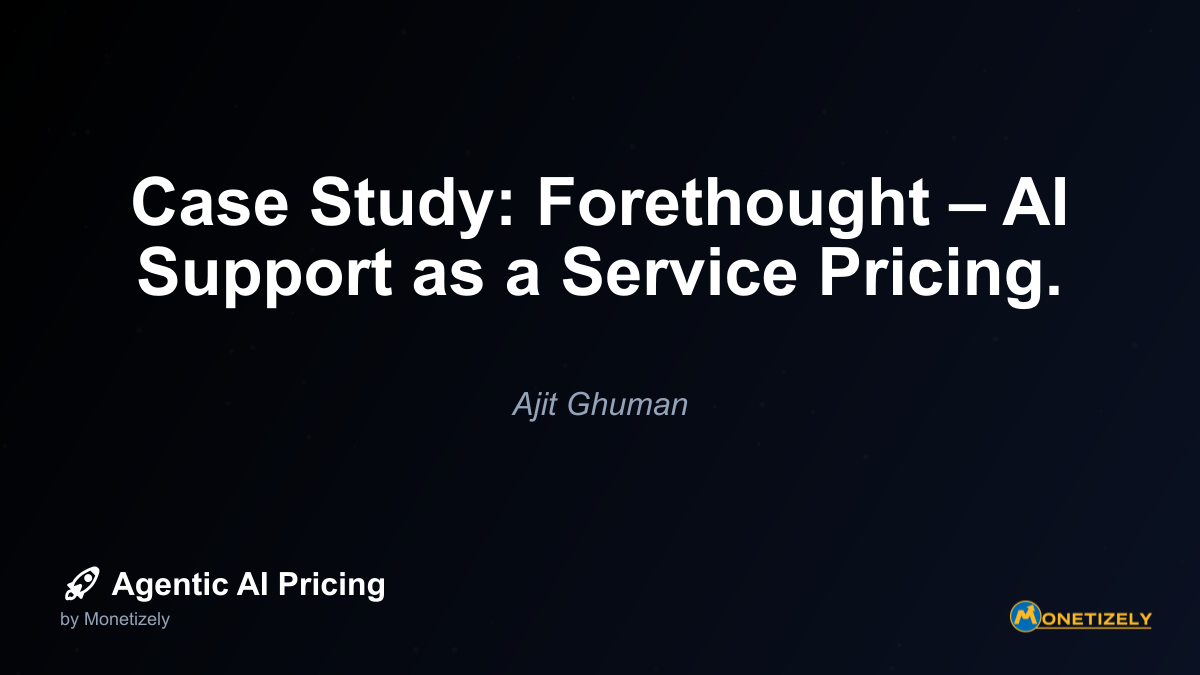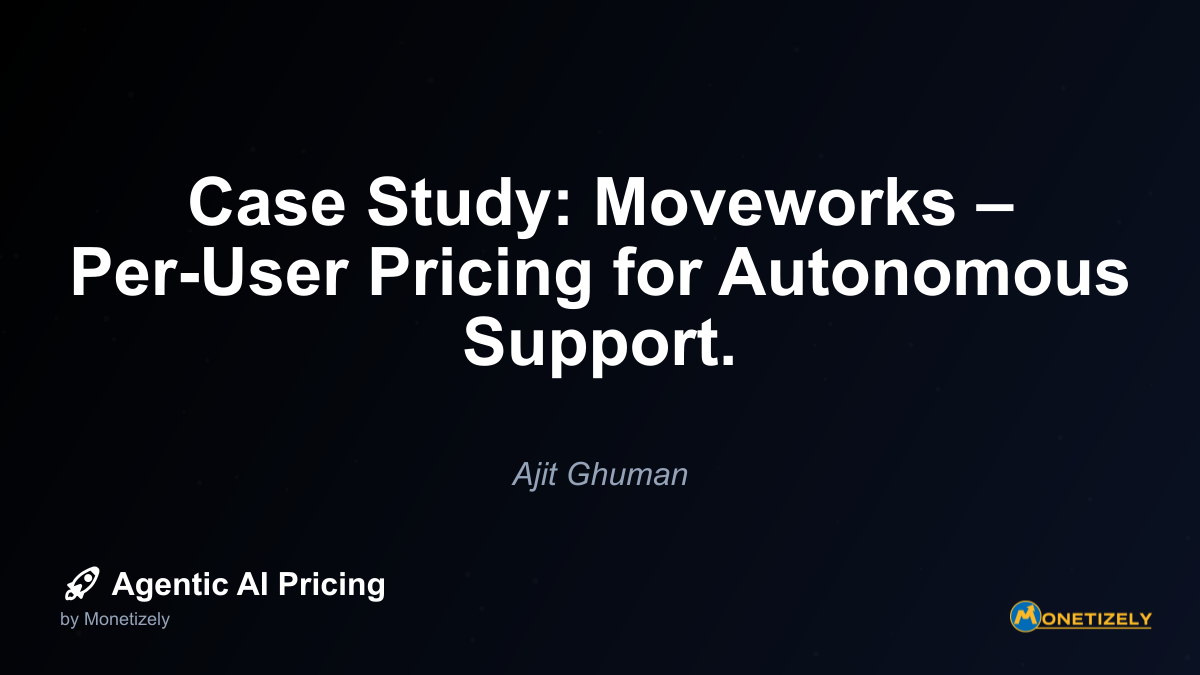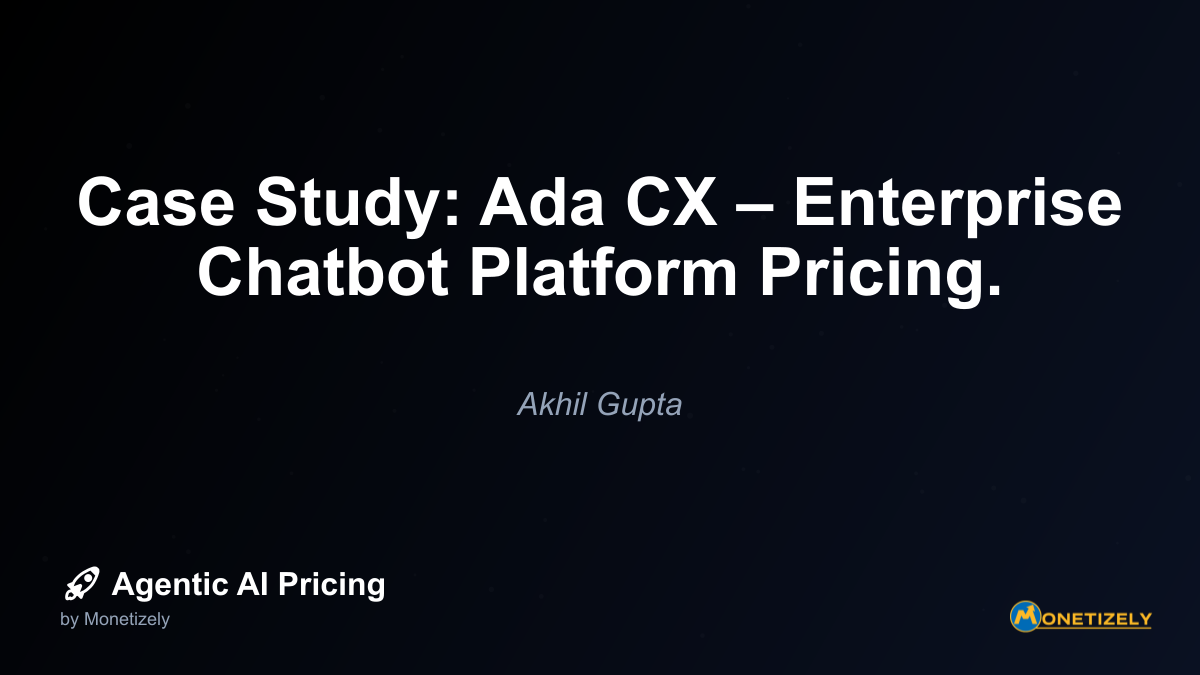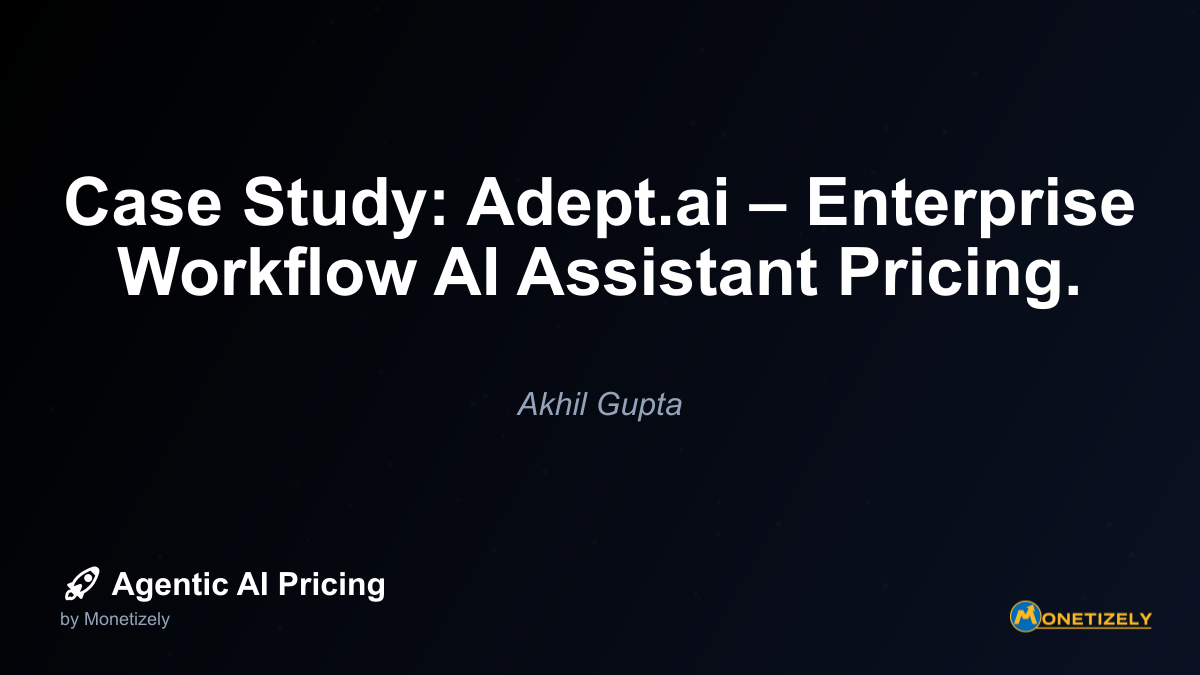· Ajit Ghuman · Case Studies · 9 min read
Case Study: Forethought – AI Support as a Service Pricing.
AI and SaaS Pricing Masterclass
Learn the art of strategic pricing directly from industry experts. Our comprehensive course provides frameworks and methodologies for optimizing your pricing strategy in the evolving AI landscape. Earn a professional certification that can be imported directly to your LinkedIn profile.

While Forethought doesn’t publicly disclose detailed pricing information on its website—a common practice among enterprise SaaS providers—industry analysis and customer testimonials reveal a sophisticated pricing approach that aligns with both the value delivered and customer support budgeting realities.
Forethought’s pricing strategy appears to incorporate several key elements:
Tiered Structure Based on Support Volume
Forethought typically structures its pricing in tiers determined by support volume metrics, such as:
- Number of monthly support tickets processed
- Number of agents using the platform
- Number of knowledge base articles integrated
- Volume of self-service interactions
This approach allows organizations of different sizes to adopt the platform at a price point proportionate to their support operations scale. Smaller companies with modest ticket volumes can implement Forethought’s AI capabilities without the enterprise-level investment that would otherwise be prohibitive.
Feature-Based Differentiation
Beyond volume-based tiers, Forethought differentiates pricing based on which components of its platform customers implement:
- Basic packages might include only TriageAI for ticket routing
- Mid-tier offerings typically add AssistAI for agent recommendations
- Premium tiers incorporate the full suite including SolveAI for customer-facing self-service
This modular approach allows organizations to start with specific pain points in their support workflow and expand their implementation as they realize value and build internal confidence in the technology.
ROI-Focused Value Metrics
Perhaps most importantly, Forethought frames its pricing discussions around concrete ROI metrics that resonate with support leaders and financial decision-makers:
- Reduction in average handle time (AHT)
- Improvement in first contact resolution (FCR)
- Decrease in cost per ticket
- Increase in agent productivity
- Growth in customer satisfaction scores
By tying pricing to these operational improvements, Forethought positions its solution not as a cost center but as a strategic investment with measurable returns. For instance, customers reporting 25-35% reductions in average handle time can easily justify the platform’s cost through agent efficiency gains alone.
How Forethought’s Pricing Compares to Traditional Support Solutions
To properly contextualize Forethought’s pricing strategy, it’s helpful to compare it with traditional approaches to scaling customer support:
Agent Staffing Costs
The fully-loaded cost of a customer support agent (including salary, benefits, training, management, and infrastructure) typically ranges from $50,000 to $75,000 annually in the US market. For organizations handling high volumes, the linear relationship between ticket volume and headcount creates significant financial pressure.
Forethought’s AI augmentation approach fundamentally changes this equation. By enabling each agent to handle more tickets effectively, the platform reduces the need for proportional headcount growth as volume increases. A typical mid-market organization might pay $100,000-$200,000 annually for Forethought but save $300,000-$500,000 in avoided agent hiring costs.
Traditional Support Software
Conventional helpdesk platforms like Zendesk, Salesforce Service Cloud, or Freshdesk typically charge:
- Per-agent monthly fees ($50-$150 per agent)
- Platform licensing fees
- Add-on costs for advanced features
Forethought positions itself as a complementary layer that enhances these existing investments rather than replacing them. This approach allows support leaders to leverage their current technology stack while incrementally adding AI capabilities where they deliver the most value.
Implementation and Onboarding: The Hidden Cost Consideration
Beyond the direct subscription costs, Forethought’s pricing model addresses a critical but often overlooked aspect of AI solutions: implementation complexity. Traditional AI projects often require significant professional services, data science expertise, and lengthy training periods before delivering value.
Forethought’s approach includes several elements that mitigate these hidden costs:
Pre-built integrations with major helpdesk platforms reduce technical implementation overhead
Guided onboarding programs that typically range from 4-8 weeks, significantly faster than custom AI solutions
No-code configuration tools that allow support operations teams to manage the solution without specialized AI expertise
Continuous learning mechanisms that improve the system’s performance over time without manual retraining
These factors contribute to a lower total cost of ownership compared to both traditional support scaling methods and custom-built AI solutions. The pricing strategy reflects this value proposition by emphasizing quick time-to-value and minimal technical debt.
Customer Case Examples: Forethought’s Pricing in Action
Examining how specific organizations have implemented Forethought provides insight into how its pricing model adapts to different support contexts:
Mid-Market SaaS Example
A B2B SaaS company with approximately 50 support agents handling 30,000 monthly tickets implemented Forethought’s TriageAI and AssistAI components. Their implementation costs included:
- Annual subscription based on ticket volume: approximately $150,000
- One-time implementation and integration: $25,000
- Ongoing optimization and training: included in subscription
The company reported a 28% reduction in average handle time and a 15% improvement in first-contact resolution within six months. These efficiency gains allowed them to absorb a 20% growth in ticket volume without adding headcount, effectively saving approximately $200,000 in avoided hiring costs in the first year.
Enterprise Retail Example
A major retail brand with over 200 support agents across multiple product lines implemented Forethought’s complete platform, including customer-facing self-service capabilities. Their investment included:
- Annual enterprise subscription: approximately $500,000
- Custom integration with proprietary systems: $75,000
- Dedicated customer success resources: included in subscription
The retailer achieved a 35% deflection rate for common inquiries through SolveAI’s self-service capabilities, representing approximately 100,000 tickets annually that never reached human agents. Combined with efficiency improvements for handled tickets, the company estimated first-year savings of over $1.2 million.
How Forethought’s Pricing Strategy Reflects Broader AI Support Trends
Forethought’s approach to pricing aligns with emerging best practices for AI SaaS pricing models that CFOs and other financial decision-makers increasingly expect to see. Several key trends are evident:
1. Value-Based Rather Than Cost-Plus Pricing
Unlike traditional software with relatively fixed development costs, AI solutions like Forethought involve ongoing computational expenses that scale with usage. However, rather than simply passing these costs to customers with a markup, Forethought prices based on the business value delivered through support efficiency and improved customer experiences.
2. Flexibility to Align with Budget Cycles
Enterprise support technology decisions often involve multiple stakeholders and complex budget approval processes. Forethought’s pricing strategy typically includes options for different payment structures:
- Annual contracts with volume commitments for predictable budgeting
- Quarterly evaluation periods with expansion options
- Professional services allocations that align with capital vs. operational budget distinctions
This flexibility helps support leaders navigate internal financial processes while still moving forward with implementation.
3. Outcome-Based Success Metrics
Rather than focusing solely on technical metrics like model accuracy or processing speed, Forethought ties its pricing conversations to business outcomes that matter to support organizations:
- Cost per resolution
- Agent utilization improvements
- Customer satisfaction impact
- Training time reduction
This outcome-oriented approach helps justify the investment to financial decision-makers who may not fully understand the technical aspects of AI but clearly recognize the business value.
Challenges and Considerations in Forethought’s Pricing Model
While Forethought’s pricing approach offers many advantages, potential customers should consider several challenges inherent in AI support pricing models:
1. Predicting Value Before Implementation
The exact ROI from AI support augmentation depends on factors specific to each organization’s support operations, including:
- Current agent efficiency metrics
- Quality of existing knowledge base content
- Complexity of support inquiries
- Language and channel distribution
Organizations considering Forethought should request detailed ROI projections based on their specific support metrics rather than industry averages to ensure accurate value assessment.
2. Scaling Considerations
As support volumes grow, the relationship between cost and value may change. Organizations should carefully evaluate how Forethought’s pricing scales at different volume thresholds:
- Does the per-ticket effective price decrease with scale?
- Are there volume discounts for larger implementations?
- How does pricing adjust if ticket volume decreases seasonally?
Understanding these scaling factors is essential for long-term budgeting and value assessment.
3. Integration Complexity Impact
While Forethought emphasizes pre-built integrations, the reality of enterprise support environments often includes custom workflows and legacy systems. Potential customers should carefully assess:
- Additional costs for custom integrations
- Timeline impacts for complex environments
- Ongoing maintenance requirements for integrations
These factors can significantly impact the total cost of ownership beyond the core subscription fees.
Future Directions in AI Support Pricing
As the AI support market matures, Forethought and similar vendors are likely to evolve their pricing strategies in several key directions:
1. Outcome-Based Pricing Components
Future pricing models may include elements directly tied to achieved outcomes, such as:
- Performance-based pricing tied to efficiency improvements
- Risk-sharing models with partial refunds if targets aren’t met
- Success fees for exceeding baseline expectations
These approaches align vendor and customer incentives more directly than traditional subscription models.
2. Consumption-Based Elements
As computational costs become more predictable and customers grow more sophisticated, hybrid models incorporating usage-based components may emerge:
- Base subscription plus usage-based components
- Volume-based pricing tiers with clearer thresholds
- Separate pricing for computational-intensive vs. standard features
This evolution would provide greater cost transparency while maintaining predictable budgeting.
3. Ecosystem Integration Pricing
As AI support becomes more interconnected with broader customer experience ecosystems, pricing may evolve to reflect this integration:
- Bundle pricing with complementary technologies
- API-based pricing for embedded capabilities
- Marketplace models allowing flexible component selection
These approaches would reflect the increasingly modular and interconnected nature of support technology stacks.
Implementing Forethought: Strategic Considerations Beyond Price
For organizations evaluating Forethought, several strategic considerations beyond direct pricing should influence the decision-making process:
1. Change Management Requirements
AI support augmentation represents a significant change to agent workflows and requires thoughtful change management. Organizations should budget for:
- Internal communications and training
- Process redesign and documentation
- Performance management adaptation
- Potential resistance management
These soft costs, while not part of Forethought’s direct pricing, significantly impact the total implementation investment.
2. Data Strategy Alignment
Forethought’s effectiveness depends partly on the quality of existing support data. Organizations should assess:
- Current knowledge base comprehensiveness
- Ticket categorization and tagging consistency
- Historical response quality and standardization
- Data governance and privacy controls
Investments in improving these areas may be necessary to maximize Forethought’s value, representing additional indirect costs.
3. Competitive Positioning
As more organizations implement AI support capabilities, the competitive landscape is shifting. When evaluating Forethought’s pricing, companies should consider:
- Customer expectations for support efficiency
- Competitor support experiences and capabilities
- Industry benchmarks for resolution times and satisfaction
- Potential competitive advantage from superior AI-powered support
These strategic factors often justify premium pricing tiers when properly quantified in business cases.
Understanding the full spectrum of AI pricing models can help support leaders better evaluate Forethought’s approach against alternatives and ensure they’re selecting the most appropriate structure for their organization’s needs.
Conclusion: Lessons from Forethought’s Pricing Approach
Forethought’s pricing strategy offers valuable insights for both support leaders evaluating AI solutions and other AI vendors developing their own pricing models:
Value alignment is paramount: By tying pricing to concrete business outcomes like efficiency gains and cost savings, Forethought creates a compelling ROI narrative that resonates with decision-makers.
Flexibility enables adoption: Through tiered structures based on volume and modular feature selection, Forethought allows organizations to start small and expand as they build confidence in the technology.
Implementation simplicity matters: By emphasizing quick deployment, pre-built integrations, and minimal technical expertise requirements, Forethought addresses the hidden costs that often derail AI initiatives.
Outcome measurement creates trust: Clear metrics tied to business results rather than technical capabilities build confidence in the value proposition and justify ongoing investment.
As AI continues transforming customer support operations, pricing models will continue evolving to reflect both technological capabilities and business realities. Forethought’s approach represents an instructive example of how emerging AI vendors can package sophisticated technology in ways that align with existing budget structures while delivering measurable business impact.
For support leaders evaluating AI augmentation solutions, understanding these pricing dynamics is essential to making informed decisions that balance immediate budget constraints with long-term strategic value. The right pricing structure should feel less like a cost and more like an investment with clear, measurable returns.
Co-Founder & CEO
Ajit is the author of Price To Scale, a top book on SaaS Pricing and is the Founder of Monetizely. Ajit has led and worked in pricing and product marketing at firms like Twilio, Narvar and Medallia. His work has been featured in Forbes and VentureBeat. Ajit regularly consults with software companies from Seed stage to post-IPO on pricing strategy. Ajit is also a highly-rated co-instructor for 'The Art of SaaS Pricing and Monetization' on Maven.
Pricing Strategy Audit
Let our experts analyze your current pricing strategy and identify opportunities for improvement. Our data-driven assessment will help you unlock untapped revenue potential and optimize your AI pricing approach.




